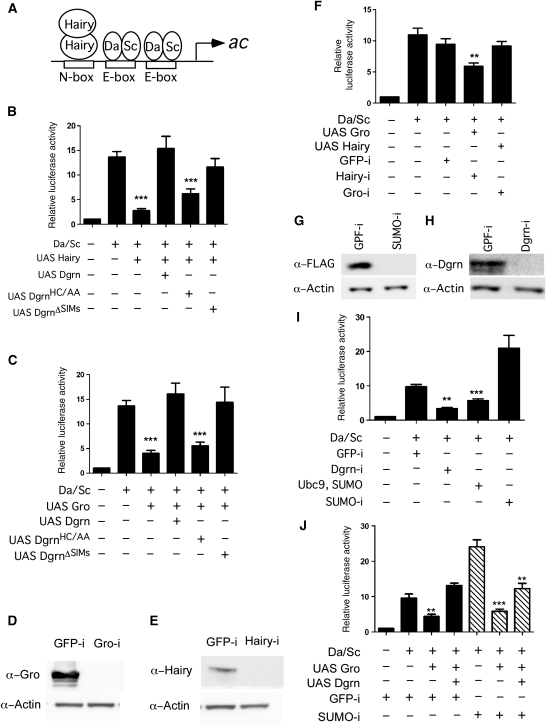Figure 3.
Dgrn antagonism of Hairy and Gro repression inversely correlates with the effects of the SUMO pathway and is partially dependent on SUMOylation. (A) Schematic diagram of the ac reporter. The binding sites for sequence-specific transcription factors are indicated. ac, Sc, Da. (B) Dgrn alleviates Hairy-mediated repression of the ac luciferase reporter. Dgrn derepression activity is compromised in the Dgrn RING finger mutant (DgrnHC/AA), and is also minimally reduced in the DgrnΔSIMs mutant. (C) Dgrn alleviates Gro-mediated repression of the ac luciferase reporter. (D, E) Protein levels of Gro (D) and Hairy (E) in RNAi-treated cells used in (F) as indicated. GFP-i serves as a non-specific RNAi control. Gro-i and Hairy-i denotes Gro and Hairy RNAi, respectively. (F) Hairy-mediated transcriptional repression is dependent on Gro and is abolished in Gro-i cells. In contrast, Gro represses transcription in cells in which Hairy is inactivated using RNAi. (G, H) Protein levels of Flag-SUMO (G) and Dgrn (H) in RNAi-treated cells used in (I) and (J) as indicated. (I) Reduced Dgrn protein levels via RNAi, or expression of SUMO and Ubc9 represses transcriptional activity. Similarly, reduction in SUMO levels increases transcription from the ac reporter. (J) While Gro can mediate repression in cells with reduced SUMO levels, Dgrn's ability to alleviate repression in these cells and fully restore the activated state in SUMO-i cells is compromised. Data were collected from five independent experiments. Statistical analysis, s.e.m. and t-test comparisons were performed using the Prism5 ANOVAs software. Significance is indicated by ***P<0.001 and **P<0.01.

